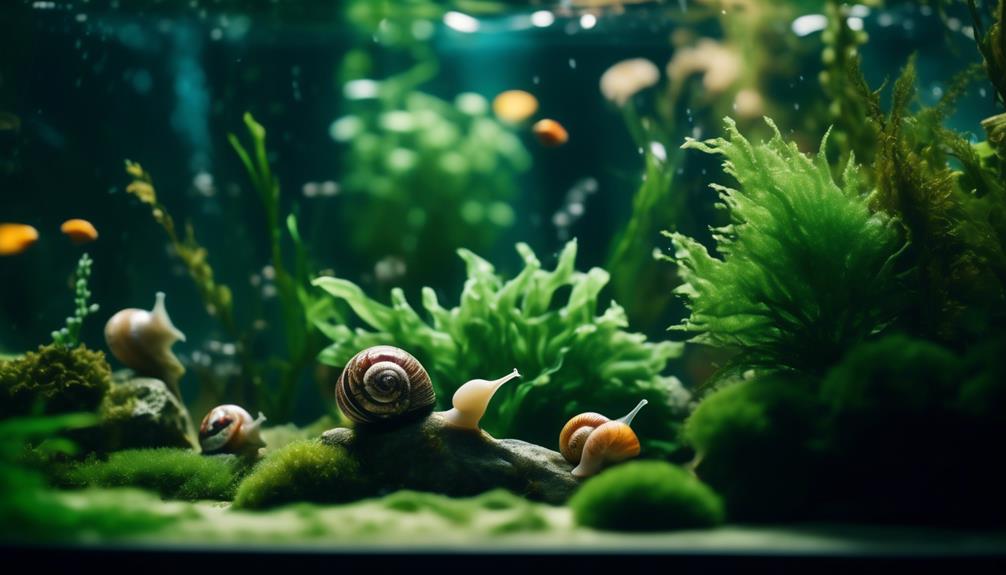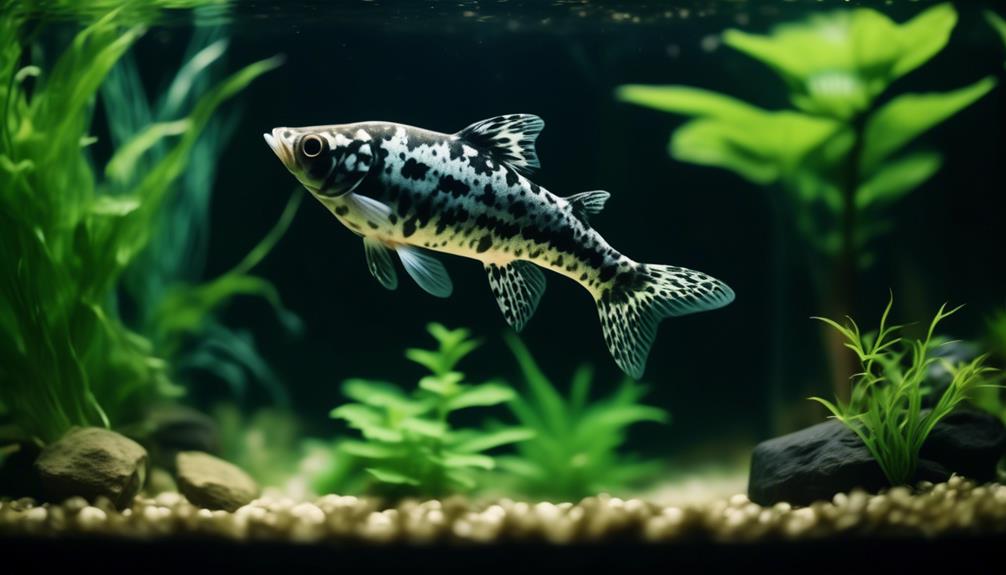Algae growth is a common concern among freshwater aquarium owners, as it can compromise the visual appeal and health of the tank.
Luckily, there are a variety of algae-eating fish and invertebrates that can effectively control and prevent algae overgrowth.
In this article, we will explore the ultimate algae-eating powerhouses for your freshwater aquarium.
From the Reticulated Hillstream Loach, renowned for its ability to clean large surfaces, to the nimble-fingered Amano Shrimp that can navigate narrow gaps, we will delve into the unique characteristics and benefits of each species.
By incorporating these algae-eating powerhouses, you can maintain a clean and aesthetically pleasing environment for your aquatic pets.
Key Takeaways
- Reticulated Hillstream Loaches, Amano Shrimp, Nerite Snails, and Otocinclus Catfish are excellent algae eaters for freshwater aquariums.
- It is important to provide the appropriate environment and diet for these algae-eating species to thrive.
- Having a group of at least three individuals is ideal for some species, while others can be kept alone.
- Consider factors such as tank size, compatibility with other fish, and the specific type of algae you want to target when choosing an algae-eating powerhouse for your aquarium.
Reticulated Hillstream Loach
The Reticulated Hillstream Loach, known for its unique cleaning abilities, is an ideal choice for freshwater aquariums seeking effective algae control. This species has the remarkable ability to clean large, flat surfaces such as vertical aquarium walls, rocks, and broad plant leaves.
With its nimble and agile nature, the Reticulated Hillstream Loach can easily navigate and remove specific types of algae, such as diatoms, from these surfaces.
When it comes to selecting tank mates, it is best to have either one or a group of three loaches, as they can be territorial.
Additionally, it is important to keep them in cooler waters with a stable pH and feed them high-quality sinking foods like Repashy gel food to ensure their optimal health and algae-eating prowess.
Amano Shrimp
Amano Shrimp, known for their nimble-fingered algae-eating abilities, are a valuable addition to freshwater aquariums seeking effective control over specific types of algae. These clear-brown dwarf shrimp can reach a length of 2 inches (5 cm) and are highly efficient at removing black beard algae and hair algae.
To make a significant dent in algae growth, it is recommended to keep a group of at least four Amano Shrimp in the aquarium. While they readily breed in the aquarium, it is important to note that the baby shrimp only hatch in saltwater.
Amano Shrimp have specific diet and feeding requirements, and they should not be overfed to ensure they can effectively eat the targeted algae. A well-balanced diet of algae-based foods and occasional supplemental feeding is recommended for their optimal health and growth.
Nerite Snails

Continuing our exploration of effective algae control in freshwater aquariums, the next algae-eating powerhouse we will focus on is the Nerite Snail. Nerite snails are adept at both scavenging and eating algae, making them an excellent addition to any planted aquarium. They are particularly handy at scraping off tough green spot algae on plants, driftwood, and decor. With many beautiful varieties to choose from, such as tiger, zebra, horned, and red racer, Nerite snails not only serve a functional purpose but also add visual interest to your tank.
To maintain a healthy population of Nerite snails in your freshwater tank, it is important to provide extra calcium in the water and diet for healthy shell development. This can be achieved by using calcium-rich substrates or adding supplements to the water. Additionally, ensure that the tank is well-maintained with proper water parameters and regular cleaning to prevent any buildup of waste or harmful substances.
Cherry Shrimp
To effectively control algae growth in your freshwater aquarium, consider adding Cherry Shrimp, a breed known for its ability to breed easily and provide excellent preventative maintenance against excess food and algae buildup. Here are three key points to know about Cherry Shrimp:
- Breeding and selling cherry shrimp for profit:
- Cherry Shrimp are highly prolific breeders and can quickly populate your aquarium.
- This presents an opportunity for hobbyists to breed and sell these shrimp to other enthusiasts, creating a potential source of income.
- Maintaining a healthy diet for cherry shrimp to prevent overfeeding:
- It is important to feed Cherry Shrimp a balanced diet to prevent overfeeding and maintain optimal health.
- Offer them a variety of foods such as algae wafers, blanched vegetables, and specialized shrimp pellets.
- Avoid overfeeding, as excess food can lead to water quality issues.
- Aesthetic appeal and versatility:
- Cherry Shrimp come in a wide range of vibrant colors, adding visual interest to your aquarium.
- They are also versatile algae eaters, as they can pick through substrate, clean plant roots, and reach into tiny crevices to eat algae.
- Their small size, reaching only 1.5 inches (4 cm) in length, makes them suitable for various tank sizes.
Otocinclus Catfish

The Otocinclus Catfish, also known as the Otocinclus affinis, is a small and slender fish commonly sought after for its ability to eat diatom algae from flat surfaces in freshwater aquariums. This catfish is an excellent choice for tank owners looking to maintain a clean and healthy environment. To provide a comprehensive overview of the Otocinclus Catfish, here is a table highlighting the best tank mates for this species and common mistakes to avoid when keeping them:
| Best Tank Mates for Otocinclus Catfish | Common Mistakes to Avoid |
|---|---|
| Corydoras Catfish | Overfeeding |
| Dwarf Gourami | Lack of hiding spaces |
| Neon Tetras | Poor water quality |
| Cherry Barbs | Insufficient food supply |
When selecting tank mates for Otocinclus Catfish, it is important to choose peaceful species that share similar water and temperature requirements. Avoid aggressive or territorial fish that may compete for resources or stress out the catfish. Additionally, be cautious not to overfeed the Otocinclus Catfish, as they are prone to being underfed. Providing a balanced diet and plenty of hiding spaces will help ensure their well-being in the aquarium.
Frequently Asked Questions
Can Reticulated Hillstream Loaches Be Kept With Other Fish Species?
Reticulated Hillstream Loaches can be kept with other fish species, but compatibility concerns should be taken into account. They are territorial and prefer to be kept either alone or in a group of three.
How Long Do Amano Shrimp Typically Live in a Freshwater Aquarium?
The longevity of amano shrimp in a freshwater aquarium can vary, but they typically live for about 2-3 years. To ensure their well-being, proper maintenance is crucial, including providing a balanced diet, stable water parameters, and a suitable environment.
Are All Nerite Snails Suitable for Planted Aquariums?
Nerite snails are suitable for planted aquariums as they are adept at scavenging and eating algae, including tough green spot algae. When choosing a substrate for planted aquariums, it is best to select one that promotes healthy root growth and provides essential nutrients for the plants.
What Is the Average Lifespan of Cherry Shrimp?
The average lifespan of cherry shrimp can range from 1 to 2 years, depending on factors such as water quality, diet, and overall tank conditions. Optimal tank conditions for cherry shrimp breeding include stable water parameters, plenty of hiding places, and a well-balanced diet.
Do Otocinclus Catfish Require a Specific Water Temperature Range in the Aquarium?
Otocinclus catfish require a specific water temperature range in the aquarium to thrive. They prefer cooler waters and a stable pH. It is important to provide a suitable tank setup with plenty of hiding places and vegetation for these algae-eating fish.
Conclusion
In conclusion, incorporating algae-eating fish and invertebrates into your freshwater aquarium can effectively control and prevent excessive algae growth. The Reticulated Hillstream Loach, Amano Shrimp, Nerite Snails, Cherry Shrimp, Otocinclus Catfish, and other species discussed in this article offer diverse strategies for maintaining a clean and visually appealing environment for your aquatic pets.
To add depth, it is interesting to note that a single Nerite Snail can consume up to 25 square inches of algae per day, contributing significantly to algae control in the aquarium.

